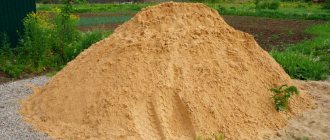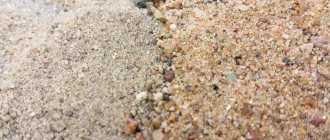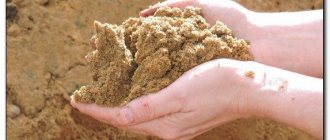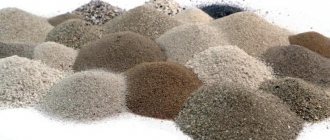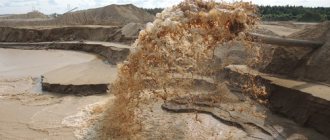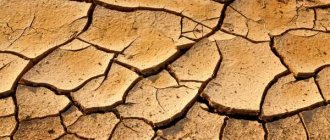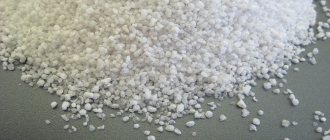Most building materials are based on natural components that have the necessary properties and are found in sufficient quantities for industrial production. Quartz sand is one of the most common natural minerals and is used in all areas of construction activities.
What ensures the chemical properties of the material?
The main component of quartz sand is silicon dioxide (quartz). Its formula is SiO2. It may also contain organic impurities, clay, oxides of iron and a number of other metals. The quartz content in the original mineral is usually at least 93-95%.
The principle of operation of building mixtures used to produce building blocks and slabs is based on the chemical interaction of the components. The inorganic chains formed as a result provide the required parameters of the material.
Silicon dioxide is an acidic oxide, so it reacts with calcium and aluminum compounds found in limestone and clay. The interaction can occur both during drying of the wet mixture and during thermal baking.
Areas of application of quartz
Quartz sand is used in a wide variety of fields - construction, industry, glass production and other areas. Well suited for sandblasting. It is often used for the production of building blocks and bricks, as well as in the production of cement mortars and all kinds of mixtures for laying asphalt.
Brick making
This type of sand is also widely used as an additive when mixing plaster solutions for exterior or interior decoration.
Preparation of plaster mortar
Another area of application for quartz sand is the manufacture of porcelain and earthenware products, which acquire the appropriate properties due to the strength of the material. Sand is also used in glass production.
Glass making
The product in question is also used in the pharmaceutical industry for the production of various types of lenses. The high abrasive properties of the material make it possible to produce perfectly smooth and durable glass.
It is impossible not to mention the use of quartz sand in the food industry, where it is successfully used for water purification. The material copes well with retaining and absorbing harmful substances, which is why it is actively used in modern filters.
Types of quartz sand and its extraction
There are natural and artificial varieties of sand, differing in the method of extraction.
Natural natural
This type of sand is ubiquitous in nature and is found at the bottom of water basins and in the soil. The sizes of most of its grains range from 0.2 to 1 mm.
There are several ways to extract quartz sand:
- Quarrying is the main method. If mining is carried out above sea level, the resulting sand is called mountain sand. Varieties of soil sand are extracted during mining in the plains. The appearance of quarry sand is distinguished by its pointed shapes and often rough surface, which makes it a valuable building material. The extracted sand can be subjected to additional processing - sifting, washing and drying. The stricter the requirements for sand properties in any industry, the more careful preparation is required. In the construction of small structures, sand is usually not subjected to any impact and is supplied directly from the place of its extraction;
- development of water basins - sand is washed out by a dredger and is characterized by high purity provided by natural washing. Mining is carried out in river beds, lakes, and marine areas. Sea sand is somewhat less valuable due to its higher content of mineral impurities. River sand has a smooth shape - under microscope magnification, the sand grains resemble sea pebbles. The use of smooth (rounded) sand is common in self-leveling mixtures - the grains of sand do not cling to each other.
This is what natural quartz sand looks like in the photo
Artificial sand
Despite its name, the mineral is of natural origin, but is initially found in the form of large crystals. To transform quartz crystals into sand, mechanical action (explosion) is used, after which the fragments are crushed.
Ordinary
As such, the concept of “ordinary” sand does not exist. This “term” is what ordinary people call material familiar from childhood from their favorite beaches and sandboxes. Therefore, each person has a subjective concept of “ordinary”.
But in 99 cases out of 100, “ordinary” means a quarry or river mineral. This is a kind of “mixture” of various rocks and impurities: quartz, silicon dioxide, loam, etc.
Methods for classifying quartz sand
The starting point in the classification system is the properties of the material and how it is prepared. The following areas of classification of quartz sand are distinguished:
By size (fractional composition)
The numerical expression is the average particle size or range of particle sizes (fraction):
- pulverized quartz – represents a fraction of less than 0.1 mm (sifted into a sieve with a pore diameter of 0.1 mm) and is usually found when crushing quartz crystals;
- fine-grained sand – fraction 0.1-0.25 mm;
- medium sand – fraction 0.25-0.5 mm;
- coarse sand – fraction 0.5-1 (rarely up to 3) mm.
By enrichment
Quartz sand is divided into unenriched and enriched sand:
- unenriched sand is the original mineral that has not been processed to increase the silica content;
- enriched sand contains a several percent increased quartz content, obtained by removing most of the impurities. Thus, white quartz sand is purified from organic compounds, iron oxides and clay impurities by sifting, washing and drying.
Due to the nature of production, the main technical characteristics of the resulting material also differ. This in turn affects the possibilities of further use of quartz sand.
Enrichment technology
High purity of the quartz mixture is a necessary requirement in a number of technological processes. The initial stage of enrichment includes fractionation and washing - with their help, the coarsest impurities are removed.
The next stage is the use of special technologies, such as:
- gravitational enrichment is the main method, the essence of which is to separate the components of the mixture by density. Lighter particles are carried away by the water flow, while heavier ones settle to the bottom of the apparatus. The gravitational effect can be enhanced by centrifugation or the addition of chemical reagents that change the wettability of sand components;
- electric and magnetic separation - is the effect of electric current and magnetic field, leading to the separation of certain impurities. Thus, magnetic action is especially effective in removing iron particles that have magnetic properties.
The parameters of enriched sand fundamentally affect the quality of the work performed. Sand mixtures with the best properties are produced only by certified enterprises using standard technologies.
By color
It can be natural or painted. Natural quartz sand ranges in color from pale yellow to brownish yellow. Artificial coloring is carried out with stable paints based on synthetic binders, allowing you to create original multi-colored ornaments from sand. This sand can be colored or white.
By degree of preparation
Depending on technological requirements, sand can be produced in the following varieties:
- fractionated - represents a specific fraction of sand, the size of which is limited by technical regulations;
- dry – dried to an air-dry state. Together with fractionated sand, it can be used as a working fluid for sandblasting machines;
- calcined sand – completely dehydrated by calcination. Heating significantly above 100 °C ensures desorption of moisture even from the deep pores of quartz. Such sand is used in ready-made building mixtures that are stored for a long time - even a slight moisture content can render the entire mixture unusable;
- rounded quartz sand – has less abrasive properties and is therefore suitable for delicate applications, for example, sandboxes on playgrounds;
- molding quartz sand – used to produce cast quartz products and is characterized by a high degree of enrichment.
Characteristics and properties
Individual grains of quartz sand range in size from 0.05 to 3 mm. Sand may contain a variety of impurities that affect its physical and mechanical properties and color. For example, the iron content in it gives the sand a brown color. Titanium is pink, pure quartz is colorless. Let's consider the main physical and mechanical characteristics:
- Radioactivity class 1;
- density is more than 1400g/cm3;
- Mohs hardness 7;
- crushability about 0.3;
- abrasion – 0.1.
Production and extraction of quartz sand
There are a significant number of large deposits of quartz sand on the territory of Russia. The most famous include the Chulkovskoye (Moscow region), Kozlovskoye (Bryansk region), Elshanskoye (Volgograd region), Berezichskoye (Kaluga region) deposits and a number of others.
The differences between quartz construction sand extracted from these places are the initially high quality parameters and higher cost. It is important to understand that the properties of sand from a nearby quarry will be quite sufficient for the construction of small country houses, so you should not overpay. If the goal is to build a large mansion, then skimping on the quality of sand can negatively affect the longevity of the house.
This is how quartz sand is extracted on a special production line:
Peculiarities
Quite often, newcomers to the construction confuse construction sand with quartz . The result is unreasonable spending of financial resources, incorrect performance characteristics and properties of the final product or object. apply them correctly .
The peculiarities of the production process and the physical and mechanical properties of quartz sand make it possible to call the material one of the most valuable in modern industry. It is not used as a filler for construction compounds , trenches are not filled, cushions are not laid, and the soil is not leveled. However, it cannot be said that quartz sand is not suitable for these purposes. The reason for the refusal is simple - in economic terms, its use in this area is completely unprofitable.
If we compare construction sand and quartz sand , it is worth noting one serious difference. The latter has a more homogeneous composition . The pores between the grains make this material one of the most dirt-resistant. At the same time, the wear of individual particles is an extremely long and complex process (7 points on the Mohs hardness scale). This property allows the material to be used in various filter systems.
How are sand characteristics standardized?
The main regulatory document is GOST 2138-91; there are also other regulatory documents (GOST 22551 77, GOST 51641 2000, 8736 93). They reflect the requirements for the main quality parameters and properties, namely:
- content of clay component. There are 5 groups with established amounts of clay from 0.2 to 2.0%;
- silicon dioxide content – from 99% to 93%, corresponding to groups from K1 to K5;
- uniformity coefficient, reflecting the variation in particle sizes relative to the average (in %). The higher the value, the more homogeneous the sand mixture. There are five groups in total (from O1 to O5), differing in their homogeneity coefficient (from 80 to 50%);
- factional composition. This parameter reflects the average particle size of quartz sand: up to 0.14 mm; 0.14-0.18 mm, 0.19-0.23 mm, 0.24-0.28 mm, more than 0.28 mm;
- humidity. Dry sands contain no more than 0.5% moisture, wet sands - no more than 4.0%, wet sands - no more than 6.0%;
- the content of metal oxides, the surface area of grains, their shape, gas permeability, as well as weight loss upon ignition are also standardized in the sand composition.
High-quality sand must have a certificate of compliance with the specified standards.
Performance properties of quartz sand
Material parameters that affect the quality of work and determine the scope of application include:
- bulk density is about 1300-1500 kg/m3;
- true density is in the range of 2600-2700 kg/m3. The true density value is used when calculating the volume of cement or concrete mortar obtained by mixing the components;
- The thermal conductivity of quartz sand is about 0.30 W/(m?°C). The shape and size of sand granules have a significant impact on the heat-insulating properties - the denser their arrangement and the smaller the gaps, the higher the thermal conductivity coefficient;
- melting point - the maximum working temperature of quartz sand is estimated at 1050 °C, which is quite sufficient for any construction work. When casting quartz products, temperatures of 1700 °C and higher are used.
- ordinary quartz sand in a loose state has a volumetric weight of 1,500 kg/m3, and a bulk density of 1,600 kg/m3.
Career
The quarry mining method is the most cost-effective. But the result is low-quality material due to the large number of different impurities. Most often it is used for rough work in the construction industry.
In some cases, quarry sand is additionally washed and screened to separate it into fractions and improve quality. But the cost of such products is much higher, so additional purification is used quite rarely.
Advantages and disadvantages of the material - overall assessment
Quartz sand is an almost irreplaceable component in many areas of application, and technologies involving it have been developed to perfection. The material gets a “5” for practicality.
The appearance of sand is familiar from childhood, and sand playgrounds are often associated with the beach and relaxation - we also give a solid “5” for appearance.
Despite the massive use of sand, its fine dust can lead to chronic illnesses among builders. The material gets a “4” for environmental friendliness.
The cost of sand is comparable to the cost of other building materials. Without having any special price advantages, quartz sand deserves a “4” rating.
The approximate cost of various fractions of quartz sand is given in the table:
| Name | Cost, rub |
| Quartz sand VS-050-1 | 3000 |
| Quartz sand fr.0.1-0.63 | 3200 |
| Quartz sand fr.0.5-0.8 | 3750 |
| Quartz sand fr.0.5-1.0 | 3750 |
| Quartz sand fr.0.8-1.4 | 3950 |
| Quartz sand fr.0.8-2.0 | 3950 |
| Quartz sand fr.1.2-3.0 | 3950 |
Along with clay and limestone, quartz sand is one of the most important and necessary components for production and everyday life. The variety of material properties provides a wide range of applications. The presence of sand quarries near the construction site significantly reduces the cost of building a house.
Main differences
| Quartz | River | Career | |
| Price | High | Average | Low |
| Scope of application | Industrial, construction | Construction, household | Construction, household |
| Degree of purification | High/medium | High/medium | Medium/low |
As for the fraction, any of their types can be both large and small. The only difference is that for quartz, the fraction will be more homogeneous; for river sand, the grains of sand will be more rounded, without clearly defined edges.
